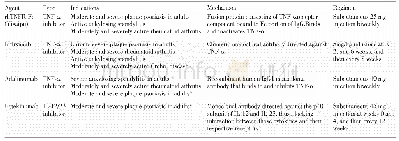《Table 2 Historical subdivision of the Devonian System in Chinaa)》
 提示:宽带有限、当前游客访问压缩模式
提示:宽带有限、当前游客访问压缩模式
本系列图表出处文件名:随高清版一同展现
《Devonian integrative stratigraphy and timescale of China》
a) XKS=Xikuangshan,STQ=Shetianqiao,DS=Dushan,XX=Xiangxian,JWZ=Jiwozhai,SJQ=Songjiaqiao,JP=Jipao.
In China,Devonian-related studies have lasted for about170 years,it started with sparse fossil descriptions and geological routine investigations in the middle 19th century,and significant palaeontological and stratigraphic works were carried out in the 1930s(Feng,1930;Grabau,1931;Yoh,1938).Tien(1938)summarized previous Devonian studies in South China,in combination with new collections from several type sections in Yunnan,Guangxi and Hunan,first subdivided the Devonian of China into lower,middle and upper series,consisting of 11 standard beds(Table 2).On the basis of Tien’s subdivision,Wang and Yu(1962)proposed to establish six Chinese regional stages,including the Longhuashanian,Sipaian/or Nagaolingian stages of the lower Devonian,the Yujiangian and Dongganglingian stages of the middle Devonian and the Shetianqiaoan and Xikuangshanian stages of the upper Devonian(Table 2).During this time,the subdivision of Devonian in China was mainly based on the stratigraphic distributions of benthic fauna(e.g.,brachiopods and rugose corals)in South China.Since the 1970s,important Devonian fossil groups which are biostratigraphically significant,including conodont,ammonite,graptolite and tentaculite,have been constantly reported in China and the biostratigraphic sequences in pelagic facies have been preliminarily established(Ruan,1979;Bai et al.,1982;Ruan and Mu,1989;Mu et al.,1988,Wang,1989).Major progresses has been made regarding international correlation and recognition of important chronostratigraphic boundaries(Wang et al.,1981;Yu,1988),manifested by the establishment of the International Auxiliary Stratotype Section of the Devonian-Carboniferous boundary near Nanbiancun in Guilin(Paproth et al.,1991).Based on the new advances in biostratigraphy in pelagic facies,Wang et al.(1974),Hou(1978)and Hou et al.(1988)revised previous Devonian chronostratigraphic division of China:(1)replacing the Longhuashanian Stage with the Lianhuashanian Stage;(2)placing the Yujiangian Stage as the third stage of the lower Devonian;(3)assigning the Sipaian to the uppermost lower Devonian;(4)establishing a new chronostratigraphic units,the Yingtangian Stage,to represent the lower part of the middle Devonian.This division has been widely accepted till the early 21th century(Table 2).
| 图表编号 | XD0034779800 严禁用于非法目的 |
|---|---|
| 绘制时间 | 2019.01.01 |
| 作者 | Wenkun QIE、Xueping MA、Honghe XU、Li QIAO、Kun LIANG、Wen GUO、Junjun SONG、Bo CHEN、Jianfeng LU |
| 绘制单位 | CAS Key Laboratory of Economic Stratigraphy and Palaeogeography, Nanjing Institute of Geology and Palaeontology and Center for Excellence in Life and Paleoenvironment, Chinese Academy of Sciences、School of Earth and Space Sciences, Peking University、State |
| 更多格式 | 高清、无水印(增值服务) |





